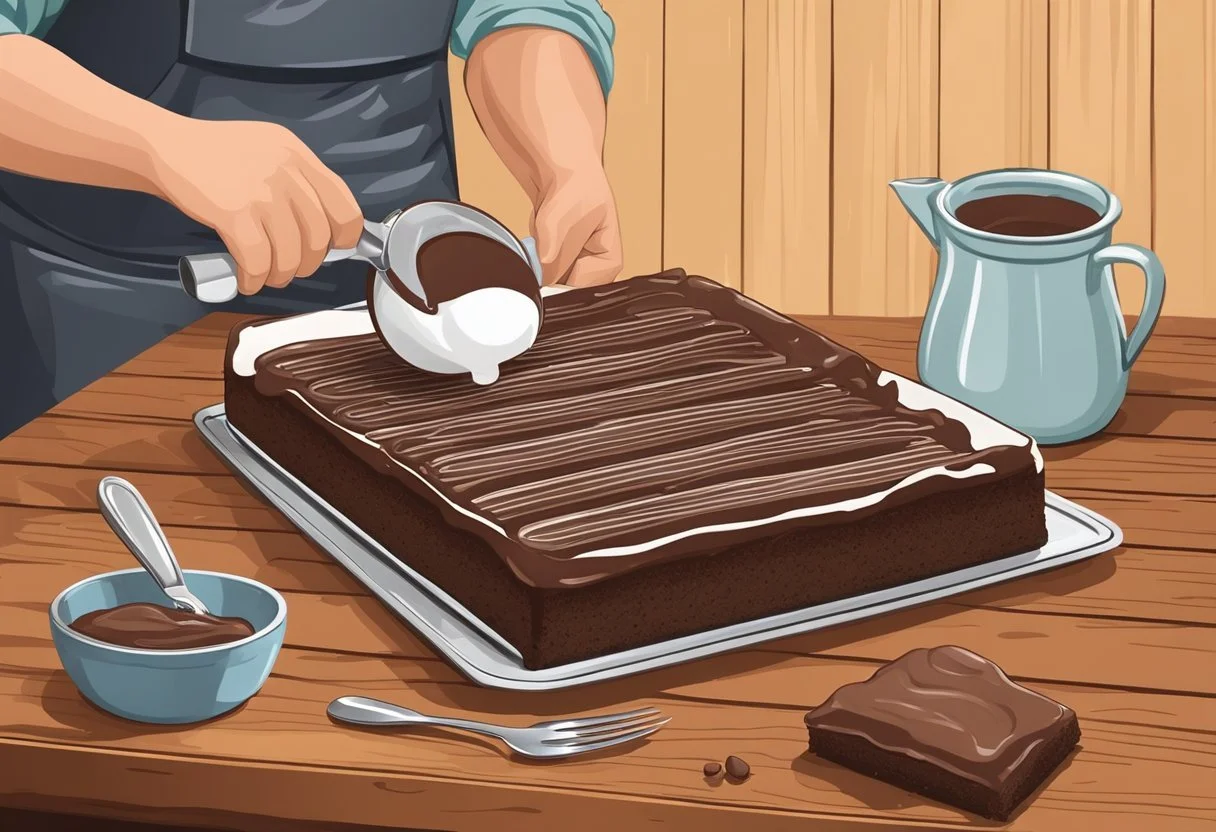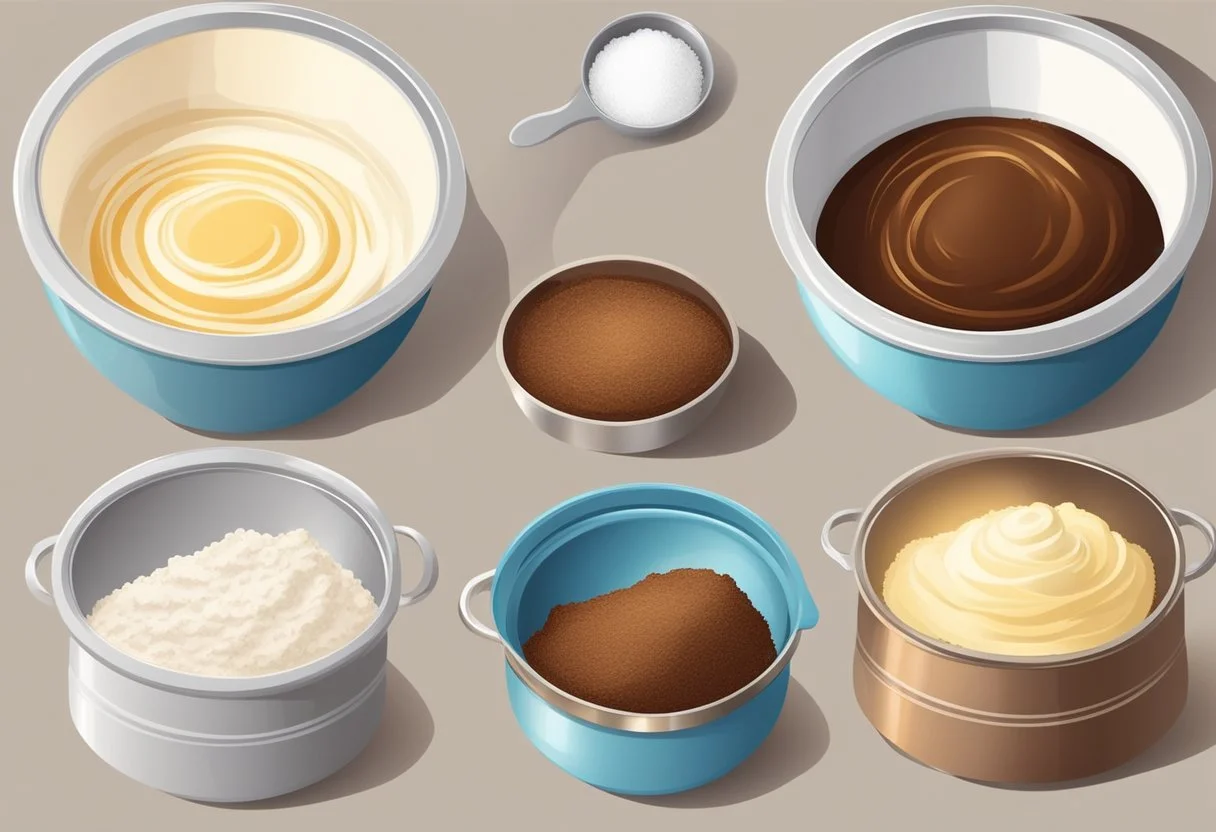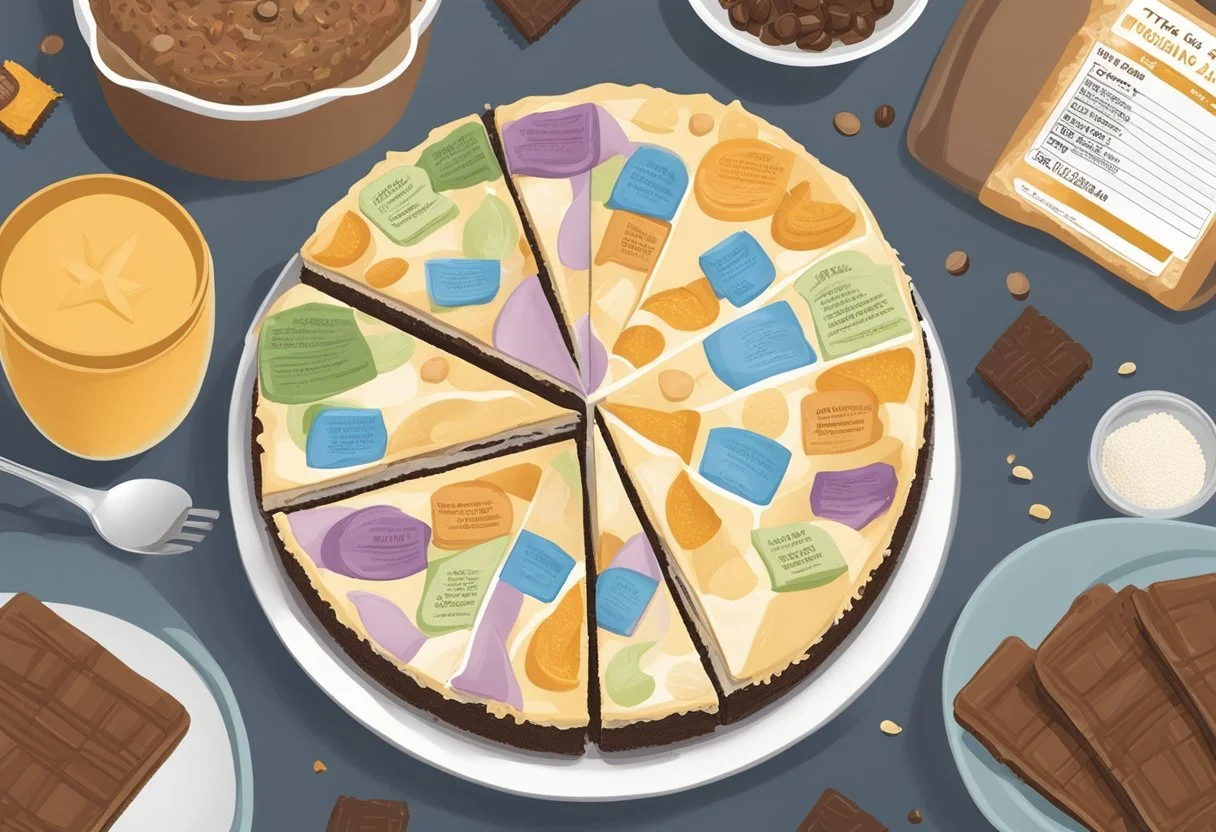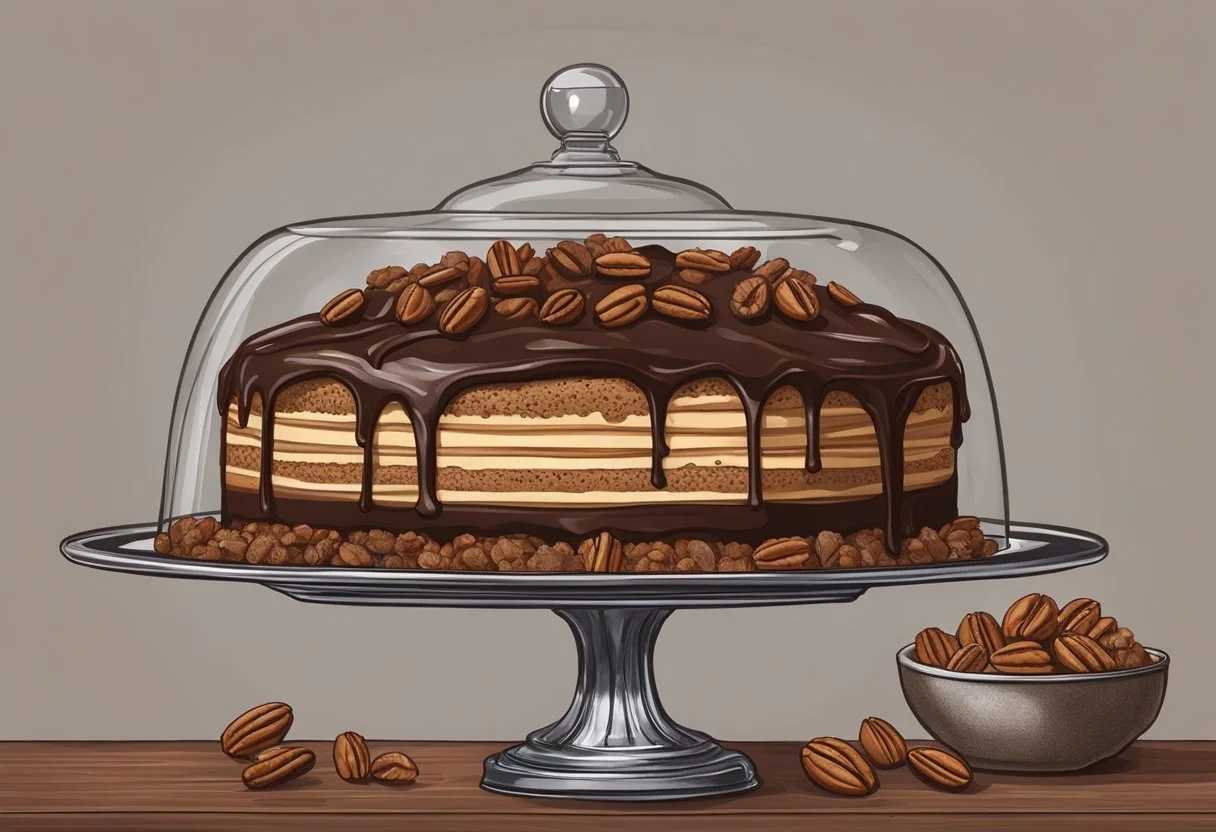Texas Sheet Cake
The Ultimate Guide for a Decadent Dessert
Discover > Truly Texan > Texas Sheet Cake
Texas Sheet Cake, a decadent dessert, has captured the hearts and taste buds of many across the United States. This delightful treat, which originated in Texas, is a rich, moist chocolate (What wine goes well with chocolate?) cake topped with a gooey chocolate frosting and pecans (how long do pecans last?). The cake's true origin remains a mystery, but one thing is certain: this Texas Sheet Cake recipe has become a staple at parties, gatherings, and celebrations wherever it is served.
What sets a Texas Sheet Cake apart from other types of sheet cakes is its unique blend of ingredients. Often made with buttermilk, cocoa powder, and cinnamon, the cake boasts a moist texture craved by dessert enthusiasts. The frosting, a critical component of this dessert, is particularly noteworthy for its fudgy and pourable nature, as it is made by combining melted butter, cocoa powder, and confectioners' sugar.
Aside from its irresistible taste, this Texas Sheet Cake recipe is also highly regarded for its simplicity and ease of preparation. As its name suggests, it is baked in a large rectangular sheet pan, allowing for faster baking times and effortless serving. The convenience and indulgence of this dessert have contributed to its iconic status in both Texas and beyond.
History and Origin
The Texas Sheet Cake recipe finds its roots in the Southern United States, where it has long been a cherished tradition at family gatherings, parties, and potlucks. The cake earned its moniker due to its large size, akin to the vast expanse of the state of Texas, as well as the rich and indulgent flavors it embodies.
This chocolate lover's dream started gaining widespread popularity around the mid-20th century. Texas Sheet Cake was often linked to German Chocolate Cake and Buttermilk Brownies as a delectable dessert that could easily be transported to social events. The original recipes mostly called for the use of buttermilk and pecans as signature ingredients, with slight variations over time.
The cake can typically be broken down into three main components:
The cake base: A moist, velvety chocolate cake made with cocoa powder, buttermilk, and sometimes coffee.
The frosting: A decadent, fudgy chocolate frosting, often infused with chopped pecans or walnuts.
The topping: Sprinkling pecans or walnuts adds crunch to an otherwise soft sponge, further enhancing its overall appeal.
In terms of preparation, one of the distinctive features of the Texas Sheet Cake is its remarkable simplicity compared to regular chocolate cake. Both the cake and frosting are typically cooked on a stovetop, making it accessible and quick. The frosting is then poured onto the cake while still warm, ensuring a smooth and even distribution, to create the best chocolate cake ever.
It's worth noting that the Texas Sheet Cake has seen some regional adaptations, with variations like the White Texas Sheet Cake and Peanut Butter Texas Sheet Cake emerging to cater to different tastes. Despite these adaptations, the core concept of a large, shareable, and decadently rich cake remains constant.
Today, its called Texas Sheet Cake and it continues to hold a special place in American culinary culture, with numerous households still delighting in this classic bake. Its signature size, rich taste, and effortless preparation make it a crowd-pleaser, perfect for sharing with friends and family with a sweet tooth. It's the only recipe many bakers turn to.
Basic Ingredients
Cocoa and Chocolate Explained
Cocoa powder is an essential ingredient in Texas sheet cake, imparting a rich, chocolate flavor. There are two types of cocoa powder available: natural and Dutch-processed. Natural cocoa powder has a more acidic and robust flavor, while Dutch-processed cocoa powder is neutralized with alkali for a milder, smoother taste. For a classic Texas sheet cake, natural cocoa powder is recommended for the best chocolate flavor.
Make your life easier by ordering cocoa powder online; it's just a few clicks away!
Understanding Flour Types
Flour (how long does flour last?) is the foundation of any cake, providing structure and texture. The most commonly used flour in Texas chocolate sheet cake is all-purpose flour. With a medium protein content, it offers a balanced combination of tenderness and structure. It is also readily available and inexpensive, making it a popular choice for most home bakers. As with any baking recipes accurate measurement of ingredients is vital.
Avoid the crowds and shop for all-purpose flour online from the comfort of your home!
Different Fats in Baking
Butter is typically used in Texas chocolate sheet cake to provide rich flavor and tender crumb. Butter contains both fat and a little water, which contribute to the overall structure of the cake. It is also responsible for the cake's velvety mouthfeel. To optimize the texture of your cake, make sure to use room-temperature butter, which is easier to work with.
Sour cream: Sour cream is another crucial fat in Texas chocolate sheet cake. It not only adds moisture but also brings a slight tanginess that complements the sweetness of the cake. As a bonus, the fat content in sour cream helps tenderize the cake's crumb. The acidity of sour cream also reacts with baking soda, creating a fluffy cake texture. Some recipes call for buttermilk and others for sour cream. Both sour cream and buttermilk add a slightly acid taste, which works well with the sweetness.
The other key ingredients for a classic Texas chocolate sheet cake recipe are:
Sugar: Granulated sugar works best in this recipe - it provides sweetness and assists in the creaming process for a fluffy texture.
Eggs: They contribute to the structure and moistness of the cake.
Vanilla extract: For flavor enhancement.
Milk: Adds additional moisture and contributes to the cake's overall tenderness.
Experience the convenience and savings of buying granulated sugar online!
Preparation Guide
Step-by-Step Baking Process
Prep: Use a preheated oven at 350°F (180°C) and grease an 18x13-inch baking sheet, sheet cake pan or jelly roll pan with butter or nonstick spray.
Dry ingredients: In a large bowl, combine flour (2 cups of all-purpose flour), a teaspoon of baking soda (how long does baking soda last?), and a pinch of salt. Set aside. The baking soda helps the sponge rise.
Boil: In a saucepan over medium heat, combine 1 cup of butter and 1 cup of water. Bring to the boil, then remove from heat.
Wet ingredients: In a separate bowl, whisk together 2 eggs, 1/2 cup of buttermilk, and a teaspoon of vanilla extract.
Mix the batter: Pour the boiled mixture into the dry flour mixture and mix well. Then, using a large spoon, gently fold the wet ingredients into the flour mixture until everything is combined.
Bake: Pour the batter into the prepared baking sheet or jelly roll pan and spread evenly. The cake bakes for 20-25 minutes, or until a toothpick inserted into the center comes out clean. Take the baking sheet or jelly roll pan out of the oven and allow the cake to cool slightly before adding frosting.
Online stores offer unbeatable prices for a baking sheet, baking soda, saucepan, and large spoon, so don't miss out!
Frosting Techniques
Boil the butter: In a saucepan over medium heat, melt 1/2 cup of butter and bring to a boil.
Add cocoa: Stir in a few tablespoons of cocoa powder to the boiling butter. Remove the saucepan from heat once combined.
Mix in sugar: Gradually add in 3 1/2 cups of powdered sugar, alternating with 1/4 cup of milk. Whisk until smooth.
Flavor and spread: Mix in a teaspoon of vanilla extract and a pinch of salt. Spread the frosting evenly over the slightly cooled cake.
Pro Tips for Mixing
To avoid lumps in the batter, sift the all-purpose flour and baking soda before adding them to the dry ingredients.
When mixing the wet and dry ingredients, use a gentle folding technique to prevent overmixing, which can lead to a tough cake.
Ensure the melted butter and water mixture is not too hot when added to the dry ingredients to avoid cooking the eggs.
If you don't have buttermilk on hand, substitute it with a mixture of 1/2 cup milk and 1/2 tablespoon of vinegar or lemon juice. Let it sit for a few minutes before adding to the recipe.
Cooking Instructions
Oven Settings and Timing
Before starting, preheat the oven to 350°F (175°C). It is essential to have the oven preheated to the correct temperature before putting in the cake, as this affects the baking time and the cake's texture.
Once the oven is heated, place the cake on the middle rack. The recommended baking time for a Texas sheet cake is approximately 20 minutes. However, factors such as oven temperature variations and the size of the pan may cause slight differences in baking time.
Testing for Doneness
Use a simple toothpick test to check if the Texas chocolate sheet cake is cooked. Around the 18-minute mark, insert a clean toothpick into the center of the cake. When pulled out, the toothpick should be free of any wet batter. If there is still batter on the toothpick, continue cooking and test again every 2 minutes until the toothpick comes out clean.
Another way to test for doneness is by observing the cake's surface. A cooked chocolate sheet cake will have a slightly firm and springy surface. If gently pressed down, it should bounce back to its original shape without leaving an indentation.
Remember, allowing the Texas chocolate sheet cake to cool down before cutting and serving is crucial for achieving the perfect texture. Once it has cooled to room temperature, add your preferred frosting, and enjoy!
Presentation and Serving
Cutting and Plating
When it comes to presenting a Texas Sheet Cake recipe, the choice of cake pan plays a crucial role. It's typically baked in either a sheet cake pan or a jelly roll pan. Once the cake is baked, allow the warm cake to cool in the prepared pan or on a wire rack. This ensures the cake structure remains intact, and it won't crumble when it's time for cutting.
To cut the cake, use a long, sharp knife or a spatula for clean and even slices. Align the knife or spatula perpendicular to the cake and gently press down before moving to the next slice. Once the slices are cut, carefully lift each piece with a spatula and place it onto the serving plate.
Discover the endless possibilities of buying a wire rack online!
Decorations
Adding decorations to your Texas chocolate Sheet Cake enhances its visual appeal. Decorations include:
Chopped nuts: such as pecans or walnuts (how long do walnuts last?), sprinkled on top of the frosting
Drizzled chocolate: melt chocolate and drizzle it over the frosting in a zigzag pattern
Powdered sugar: use a sifter to lightly dust the top of the cake with powdered sugar
Regardless of your chosen garnish, keep in mind that Texas Sheet Cake is a simple yet delicious dessert. It's important to strike a balance between presentation and the cake's classic taste, without going overboard on the embellishments.
Nutritional Information
Calorie Breakdown
A typical serving of Texas sheet cake (1/20th of the cake) contains approximately 350-400 calories. The calorie breakdown is as follows:
Carbohydrates account for 50-55% of the total calories, mainly due to the presence of flour and sugar in the recipe.
Fats account for about 40-45% of the total calories, coming from butter, oil, and cocoa powder.
Proteins contribute a smaller portion with 5-10% of the total calories, primarily from eggs and milk.
Dietary Components
The following table provides an overview of the key nutritional components in a single serving (1/20th of a Texas sheet cake):
Please note that these values are approximate and may vary based on specific recipe ingredients and serving sizes.
It's important to consider the sources of the different dietary components in a Texas sheet cake. Saturated fat, for instance, mainly comes from the butter and cocoa powder used in the recipe. Reducing the amount or substituting healthier alternatives like coconut oil or Greek yogurt could help lower the saturated fat content.
In terms of sugars, most Texas sheet cake recipes call for granulated sugar and powdered sugar in both the cake and the frosting. Using natural substitutes like honey, maple syrup, (how long does maple syrup last?) or stevia can help reduce the overall sugar content while still maintaining the cake's sweetness.
Storage and Preservation
Freezing and Thawing
To store Texas sheet cake for a longer duration, it can be frozen. Follow these steps to ensure proper preservation:
Allow the cake to cool completely.
Wrap the cake in plastic wrap, ensuring it's well-sealed to prevent freezer burn.
Place the wrapped cake in a shallow, airtight container or a resealable freezer-safe bag.
Label the container with the date and type of cake.
Store in the freezer for up to 3 months.
To thaw a frozen Texas sheet cake, remove it from the freezer and follow these steps:
Place the wrapped cake in the refrigerator for several hours or overnight to thaw slowly.
Once thawed, remove the cake from the refrigerator.
Unwrap the cake and place it on a serving platter.
Allow the cake to reach room temperature before serving.
Maintaining Freshness
To store a Texas sheet cake at room temperature, follow these guidelines:
Keep the cake in an airtight container or cover it with a cake dome to stop it drying out.
Store the cake at room temperature (between 65-70°F) away from direct sunlight or heat sources.
Consume the cake within 2-3 days for optimal freshness.
Additionally, for those who prefer to refrigerate the cake:
Place the cake in an airtight container or wrap it in plastic wrap.
Store the cake in the refrigerator for up to 5 days.
Allow the cake to reach room temperature before serving for best taste and texture.
Variations and Substitutions
Nut-Free Options
For those with nut allergies or simply wanting a nut-free alternative, Texas sheet cake can easily be made without pecans or walnuts. In this case, simply exclude the chopped pecans from the icing and the cake will still taste delicious. However, if you would like to add a bit of crunch in place toasted pecans or of nuts (how long do nuts last?), consider these options:
Sunflower seeds or pumpkin seeds (how long do pumpkin seeds last?): These seeds can be toasted and added to the icing for a nutty flavor and texture.
Cereal: Try adding crushed cornflakes or rice cereal to the icing for a subtle crunch and extra volume.
Gluten-Free Adaptations
Making a gluten-free Texas sheet cake is simple, thanks to the availability of various gluten-free flours on the market. When making your batter, replace the all-purpose flour with a gluten-free flour blend. A few common gluten-free flour blends include:
Almond flour: A popular option for its nutty flavor and fine texture.
Oat flour (how long does oat flour last?): A mild-flavored option that works great for cakes and baked goods.
1-to-1 Gluten-free baking flour: These mixes ensure the right balance of ingredients for a successful gluten-free cake.
Additionally, ensure that the pure vanilla extract and any other flavorings or ingredients used in the recipe are gluten-free.
Vegan Alternatives
Making a vegan Texas sheet cake requires substituting a few key ingredients:
By making these simple swaps, you can easily create a delicious and satisfying vegan Texas sheet cake that everyone can enjoy. Furthermore, if you'd like to incorporate elements from the traditional German Chocolate Cake into your vegan Texas sheet cake, consider adding a coconut-pecan frosting on top, using vegan butter and plant-based milk.
FAQs and Common Issues
Troubleshooting Common Mistakes
Lumps in the batter: To avoid lumpy batter, sift the dry ingredients and mix the wet and dry ingredients until just combined. Overmixing can cause lumps and affect the texture of the cake.
Texture issues: If your Texas sheet cake turns out dry or dense, it could be due to over-baking, inaccurate measurements of ingredients or heavy mixing. Use a toothpick to test doneness and ensure the oven temperature is accurate.
Difference between sheet cakes and chocolate brownies: Sheet cakes are generally thinner and lighter than brownies. Brownies have a dense, fudgy texture, while sheet cakes, like Texas sheet cake, have a tender crumb.
Coffee in the recipe: Some Texas sheet cake recipes use coffee to enhance the chocolate flavor. If you prefer not to use coffee, simply substitute with water or milk.
Scaling Recipes for Different Sizes
Texas sheet cakes are traditionally made in a large sheet pan. If you want to make a different size cake, follow these general guidelines for scaling while keeping an eye on baking times:
9x13 inch pan: Use half of the recipe and reduce the baking time by about 5 minutes.
Double-layer 8-inch round cake: Use the full recipe divided between two pans, adjusting the baking time as needed by checking for doneness with a toothpick.
Cupcakes: Use the full recipe and fill cupcake liners 2/3 full. Bake for 18-22 minutes, checking for doneness with a toothpick.
Keep in mind that changing the pan size may affect the cake's texture and appearance.
Nutritional Information
Nutrient values vary based on specific ingredients used. Here are some common nutrients and their approximate amounts in one serving of Texas sheet cake:
To reduce carbohydrates, consider using sugar substitutes and low-carb flour alternatives. However, keep in mind that these substitutions may affect the taste and texture of the cake.
Conclusion
Texas sheet cake has a rich chocolatey flavor and moist texture, to bring joy to both children and adult chocolate lovers. In this final section, we provide some helpful tips, nutritional information, and recommendations for creating your own version of this Southern classic.
For those who want to put their own spin on the Texas sheet cake, keep these tips in mind:
Experiment with different toppings, such as chopped nuts, caramel drizzle, or chocolate chips (how long do chocolate chips last?).
Play around with spices, like cinnamon or cayenne, to add a unique flavor twist.
Incorporate various nuts, such as walnuts or pecans, into the batter to provide an extra layer of texture.










